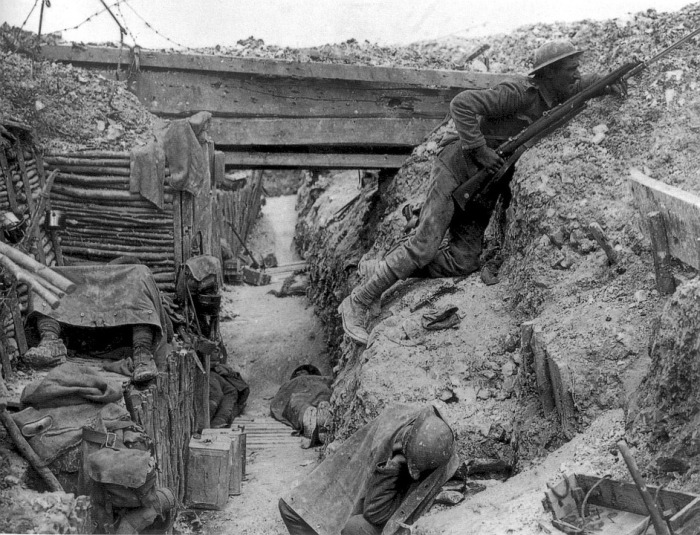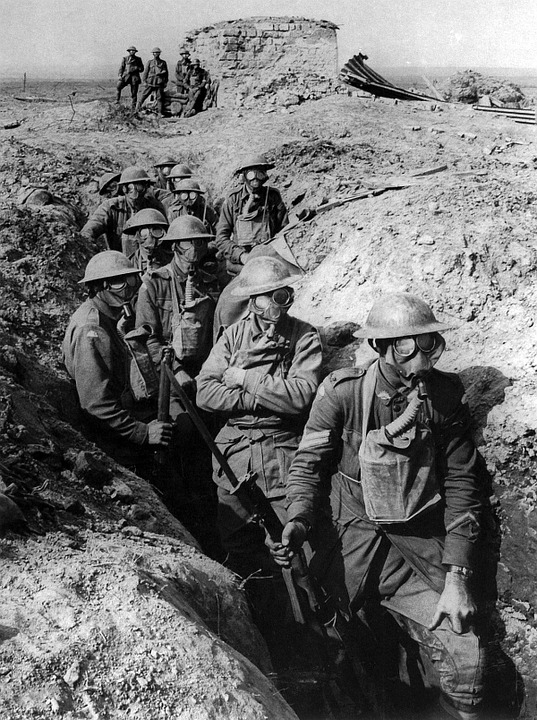
The obvious failure of conventional infantry tactics in the early years of the First World War led to agonized soul-searching in the leadership elements of the belligerent nations. How could the stalemate be broken? How could ground forces move forward, and restore some sort of war of maneuver?
Something radical needed to be done, to be sure. The standard, boilerplated attack at that time always was some version of the same script: a lengthy artillery barrage was then followed by a ponderous “advance” by massed infantry units. Such attacks would quickly fizzle out under intense machine-gun fire, and involved terrible casualties for questionable gains.
The conflict had settled into a grinding war of attrition, as the combatants hammered away at each other in set-piece battles. The most horrific of these was the Battle of Verdun, which surely must rank as the most sinister battle of the war: for here, the object was not even the seizure of territory or men. It was pure, industrialized killing. It was a calculated attempt to bleed the enemy white by killing as many of its men as possible. Verdun was–and remains–the terrifying apotheosis of attrition.
This was not to say that solutions had not been sought. Some indeed were. It was just that they did not work. Poison gas had some initial shock value, but quickly proved to be of dubious value. Tanks seemed to offer a way out of trench warfare, but military planners failed to produce them in proper numbers, or deploy them in sufficient concentrations. This seems surprising in retrospect, but we must remember that what seems obvious decades after an event is never so clear at the time. Their time had not yet come.
But one innovation did work. And it was revolutionary enough that its principles found applicability long after the First World War ended. The Germany Army’s “stormtrooper” tactics proved the one thing that could break the trench deadlock and restore the war of maneuver. Although the Germans were unable to deploy these tactics on a large enough scale to change the outcome of the war, these Sturmtruppen (shock troops) using infiltration in the attack produced some incredible results at the theater level in 1918. If the United States had not entered the war in strength in that year, France and Britain might have seen some catastrophic defeats in the West.

It was actually a French infantry captain who laid the theoretical basis for infiltration tactics. André Laffargue in 1915 wrote a pamphlet advocating for the essentials of infiltration in offensive, but he was unable to make himself heard in the labyrinth of the French military bureaucracy. The British Army leadership was hopelessly wedded to the past. It would be for Germany to bring the new doctrine to full realization.
A German Captain named Willy Rohr would be the visionary to take the new doctrine out of the pages of books and into reality. Rohr had already seen some action in the war as an infantry officer and had developed his own ideas based on personal experience and observation. He knew that the new tactics would work, provided that sufficient training and resources were devoted to the project.
Despite its reputation as a stiff, autocratic organization, the German Army in 1917-1918 was in fact far from this. It had a disciplined, well-trained corps of small-unit leaders and junior officers who often far outshined their Allied counterparts when it came to exercising initiative and innovation. And this was why they developed the new tactics, and not the Allies.
The main points of Rohr’s “stormtrooper” doctrine were the following:
1. Use decentralized, small units, rather than large ones, to bypass strong points in the enemy line.
2. Attack and cripple nerve centers and other “soft” targets. Aim in the first wave to disrupt and paralyze, rather than to destroy and occupy ground. Let future waves of infantry mop up the rest.

3. Use “mission orders.” Mission orders are orders in which commanders state objectives and goals, rather than a detailed description of how something should be done. In simple terms, mission orders tell someone what to do, and let him decide how to do it. This frees up the small unit leader to use his own initiative and creativity. It gets rid of micromanagement at the unit level, and increases the tempo of operations, since leaders do not need to check with their superiors before doing everything.
4. Rely on initiative. Promote and rely on those who show initiative, and disfavor those who do not. The only way to overcome the confusion and disorder of battle is to have men who can use their on initiative on the spot to make decisions. Making decisions and carrying them out faster than the enemy will jump-start operational tempo, and will keep the enemy permanently off-balance.
5. Use different equipment that is better suited to the job. Rohr liked weapons that focused on speed and maneuver. He emphasized grenades, shorter rifles or portable automatic weapons, flamethrowers, and light mortars. The trooper should move quickly in small squads, destroying critical obstacles, and keep moving forward.
These were the infantry tactics that Rohr and his men revolutionized. The artillery barrage was not abandoned, but its focus changed. Brief, short barrages were followed by all-out assaults by small units of storm troops using grenades, flamethrowers, and other light weapons.
Using these new methods, the Germans made rapid advances on the Western front in the last phase of the war in 1918. In March 1918, they launched a series of four coordinated attacks (Operation Michael) that aimed to break through the Western front completely. Although the Germans were not strong enough to sustain the offensive, it made incredible gains on the ground, and proved the worth of the new tactics. In the postwar period, the world’s major military organizations internalized these lessons, and adapted their forces accordingly.
The storm tactics even have applicability outside the military sphere. In trying to get any project completed, one must be mindful of these general principles. Do not micromanage; avoid the enemy’s strong points; use “mission orders”; strike hard and fast. And keep moving.
Read More: Coping With Extreme Adversity (Podcast)

You must be logged in to post a comment.